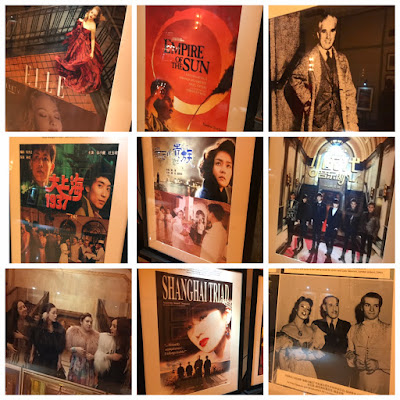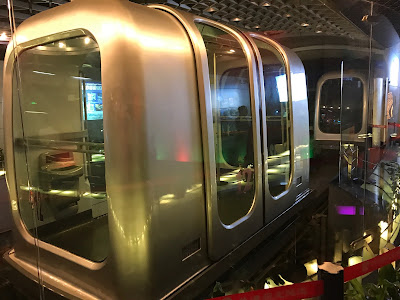And if you've done hot yoga before, you know too that some people pass out within just a few minutes of being in the hot room. That's how bad it was. I knew I would pass out if we don't exercise some prudence so my friends and I decided to scrap a lot of sightseeing plans. Our unanimous decision was to just stay in the hotel most of the time.😂 Good thing our hotel was nice because a friend got discounted rates.
We stayed at the Fairmont Peace Hotel. The hotel is along the Bund (the popular waterfront of central Shanghai).
 |
| View from the side entrance of Fairmont Peace Hotel |
The Fairmont Peace Hotel used to be known as the North Building of the Sassoon House. It was named after Sir Victor Sassoon who was the biggest real estate tycoon in Shanghai in the early 20th century. According to Wikipedia, the Sassoon House was one of the first skyscrapers in the Eastern Hemisphere. It was constructed between 1926 and 1929. So this structure is at least 88 years old.
 |
| The Sassoon House, now the Fairmont Peace Hotel |
By today's standards, the structure doesn't look like a skyscraper at all, right? So how high were skyscrapers in the 1920s? The Sassoon House is 77 meters (253 feet) high to the roofline and 83 meters (272 ft) to the spire. In terms of no. of floors, that's only about 10 floors high. So that's what skyscrapers were like in the 1920s.
When you google about what to see in The Bund, some blogs would name the Fairmont Peace Hotel as a starting point for a walking tour. Check out the hotel's main lobby -
And its beautiful dome -
Fairmont Peace Hotel has also been used for several movie shoots since the 1930s. In one hallway of the hotel, you'll see an exhibit of the movie posters and scenes shot in the hotel.
 |
| Movie Poster Exhibit at the Fairmont Peace Hotel |
Here's a collage of some of the movie posters I saw in the exhibit and photos of popular personalities who have stayed in the hotel -
 |
| Some of the movies shot at the Fairmont Peace Hotel |
On the upper right is Charlie Chaplin and on the lower right are Greer Garson, Sir Victor Sassoon and Sir Laurence Olivier.
Fairmont Peace Hotel has also a museum called the Peace Museum which houses memorabilia of the hotel such as antique silverware, porcelain, crystals and Art Deco furnishings. The hotel has a long history - in the 1930s-1940s, Cathay Hotel occupied the 4th to 9th floors of the Sassoon House. In the 1950s, it was called The Peace Hotel. In 2007, it was renovated and was re-opened in 2010 as the Fairmont Peace Hotel.
 |
| The Peace Museum which houses some hotel memorabilia |
BTW, here's our room. It's super comfy and nice. It also has a dressing room and couch area.
As welcome fruits, there was a platter of Chinese dates. Initially, I thought they were "mansanitas" (this is a Pampanggo term for a fruit but I don't know what the Tagalog or English equivalent is. Haha...). Then I saw the welcome card which described the dates as - Jujubes, indigenous in Central and Southern China, crispy texture, slightly sweet flavor and commonly used in traditional medicine as stress reliever. I ate one and I super loved it! Crispy and sweet is the perfect description. We bought more to eat and to bring home. So now when I say that I had a lot of dates when I was in Shanghai - breakfast, lunch and dinner - you know what kind of dates I am talking about. 😂 😂😂
So what did we see outside of the hotel in the few occasions when we decided to go out? 😆 The Bund and places within 3km radius from our hotel. 😂
Here are photos I took of The Bund area one evening. The lighting at night is just amazing.
The Bund was a major financial hub of East Asia in the beginning of the 20th century. There are 26 buildings that dot the 1.5km stretch of The Bund (Zhongshan Road). Together with the Peace Hotel, these buildings were the skyscrapers of the early 20th century. These structures used to house banks, businesses, newspaper offices and consulates.
 |
| The Bund |
Because the buildings are art-like showcasing various architectural styles like Gothic, Baroque and Renaissance, the Bund is also sometimes referred to as a "museum of international architecture".
BTW, if the Fairmont Peace Hotel is the North Building of the Sassoon House, the South Building of the Sassoon House is now called the Swatch Art Peace Hotel - another beautiful structure along the Bund.
 |
| Swatch Art Peace Hotel |
Notice the consistently great lighting of the buildings?
Here's the Bund viewing deck where you'll see the old skyscrapers facing the modern skyscrapers divided by the Huangpu River.
These 2 strips divided by the Huangpu River are also referred to as (1) Puxi, West of the river, where The Bund is, and (2) Pudong, East of the River, where the modern high-rise structures are. Check out the modern skyscrapers -
 |
| At the center is the Oriental Pearl TV Tower, the 6th highest tower in the world. |
 |
| See the tall building on the right? That's Shanghai Tower, the world's second tallest building by height to architectural top (the tallest is Dubai's Burj Khalifa). |
To cross the Huangpu River from the Bund, you can take a Maglev train at the Bund Sightseeing Tunnel. (What is maglev? It's derived from the word "magnetic levitation". In simple terms, the vehicle moves along a magnetized pathway.)
 |
| Maglev train at the Bund Sightseeing Tunnel |
The ride takes about 3 to 5 minutes to cross the river.As you pass through the tunnel, there is a lights and sounds show.
Here's how the Oriental Pearl TV Tower looks like during the day. Its design, they say, is composed of large and small pearls dropping on a plate of jade.
Here are the other modern skyscrapers - can't identify though which are these buildings. Haha... But for some perspective, check out the bottom portion of the photo. See the people walking along the bridge? They look like ants against the tall structures!
BTW, we spotted this vending machine inside a mall. Just insert a bill and it would produce freshly-squeezed orange juice right before your eyes. Yum!
 |
| Fresh orange juice vendo |
Another area we visited - still walking distance from the Bund 😂 - is the Yuyuan Garden. This beautiful garden was finished in 1577 which makes it 440 yrs old! Wow.
 |
| Yuyuan Garden |
What's the story behind it? Yuyuan Garden was built by a government officer during the Ming Dynasty for his parents as a place for his parents to enjoy a happy time in their old age. It's aptly called Yuyuan Garden as "Yu" in Chinese means pleasing/satisfying.
Near the Yuyuan Garden is a temple called City God Temple of Shanghai, a Taoist temple where people pray for good fortune and peace.
 |
| City God Temple |
 |
| Visitors praying for good fortune and peace. |
 |
| The writings on the red ribbons are prayer petitions. |
 |
| Spotted this beautiful collection of cups in one of the structures inside the City God Temple. |
I was so glad we visited the Yuyuan Garden and City God Temple area coz it really looked like Chinatown versus the photos I took in the Bund area which look more European than Chinese. 😆
Right outside the temple and garden, there are a lot of Chinese souvenir stores.
A unique item you can get are Chinese signature chop or name stamps. If you don't know how to write your name in Chinese, no worries, they could translate it for you.
One last thing about my Shanghai trip - which is probably the most striking experience for me in Shanghai. I got shocked by the density of people. Crossing the street to get to our hotel was a struggle. Every intersection felt like a Shibuya Crossing experience for me. 😂😂
For some context, our hotel is located at the corner of Zhongshan Road and Nanjing Road. I read somewhere that Nanjing Road is known as the pedestrian street but I didn't see any explanation why. But after one evening of exploring Nanjing Road, I finally understood why.
Why a pedestrian street? At a certain time during evenings, cars are no longer allowed to pass through the streets because the lanes are packed with people and the traffic lights are meant to be followed by the pedestrians! Seriously! 😆
Check out this intersection where there are traffic enforcers making sure pedestrians stop when the traffic light turns red and go when the light turns green. And just like cars, each lane is for one direction only. If a traffic enforcer sees you going against the flow, they will call your attention and ask you to transfer to the opposite lane.
Check out how packed the lanes are - take note, this is on a weekday!
On our last evening, we had dinner at the Victor's Cafe at ground floor of the Peace Hotel and here's the view from the cafe window. Again, this was on a weekday. It's just crazy! It looks like there's a rally all the time. I can't imagine how Nanjing Road looks like on a weekend or even worse, during peak season. 😆
That's 5 days in Shanghai. Half of my post are about things to see inside Peace Hotel and the other half are all walking distance from the hotel. Now you know I was serious when I said we stayed inside the hotel most of the time. 😂😂😂
















